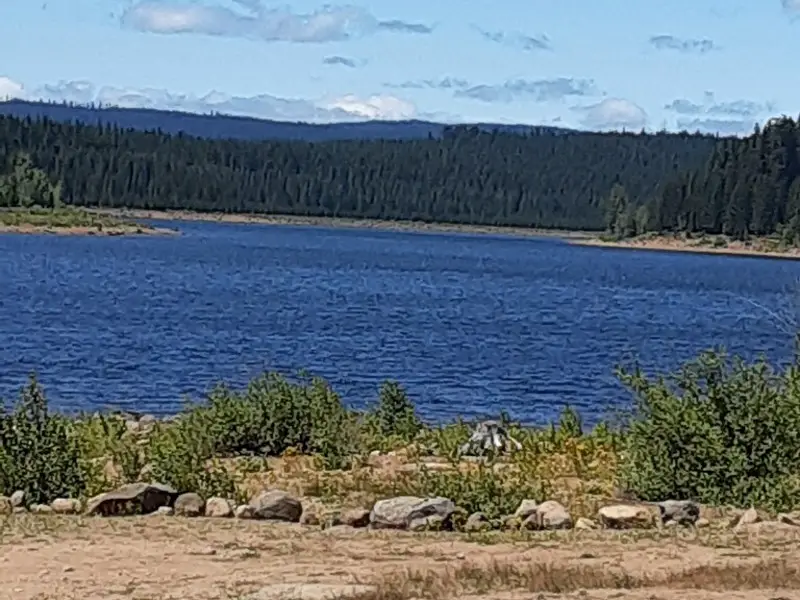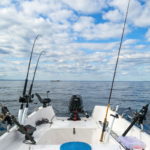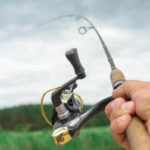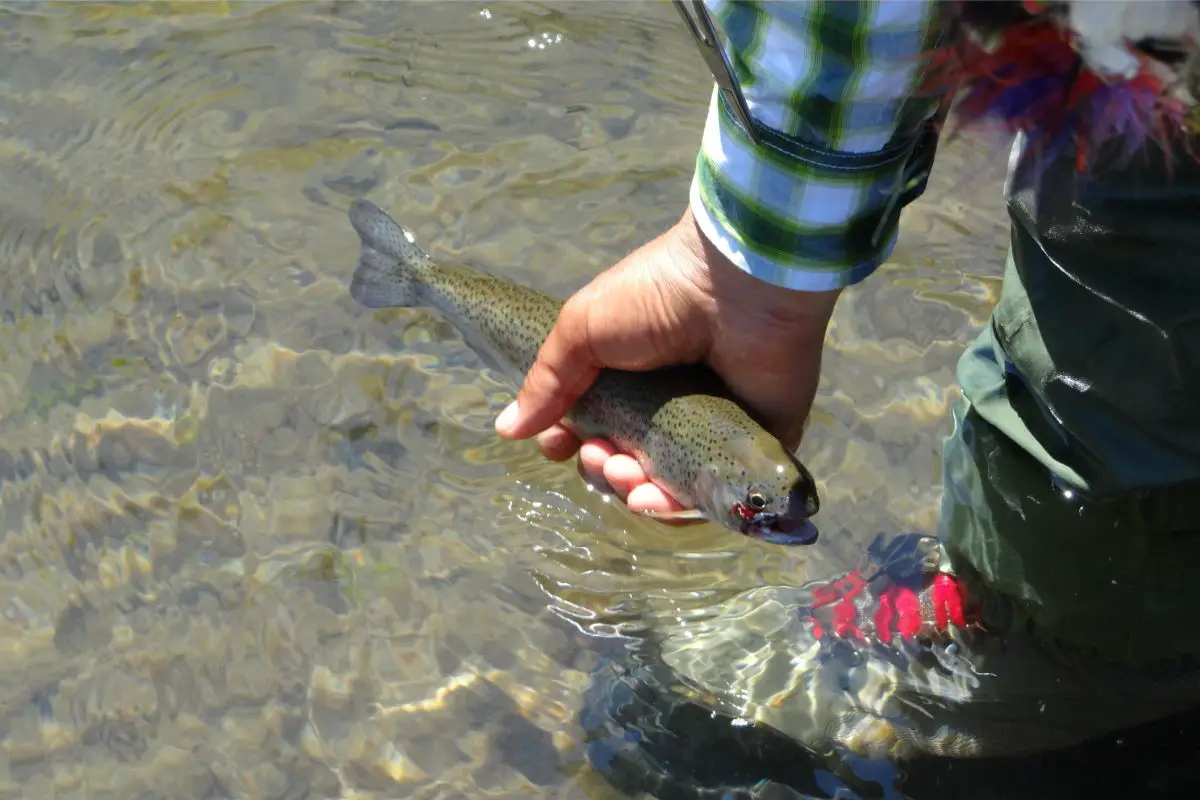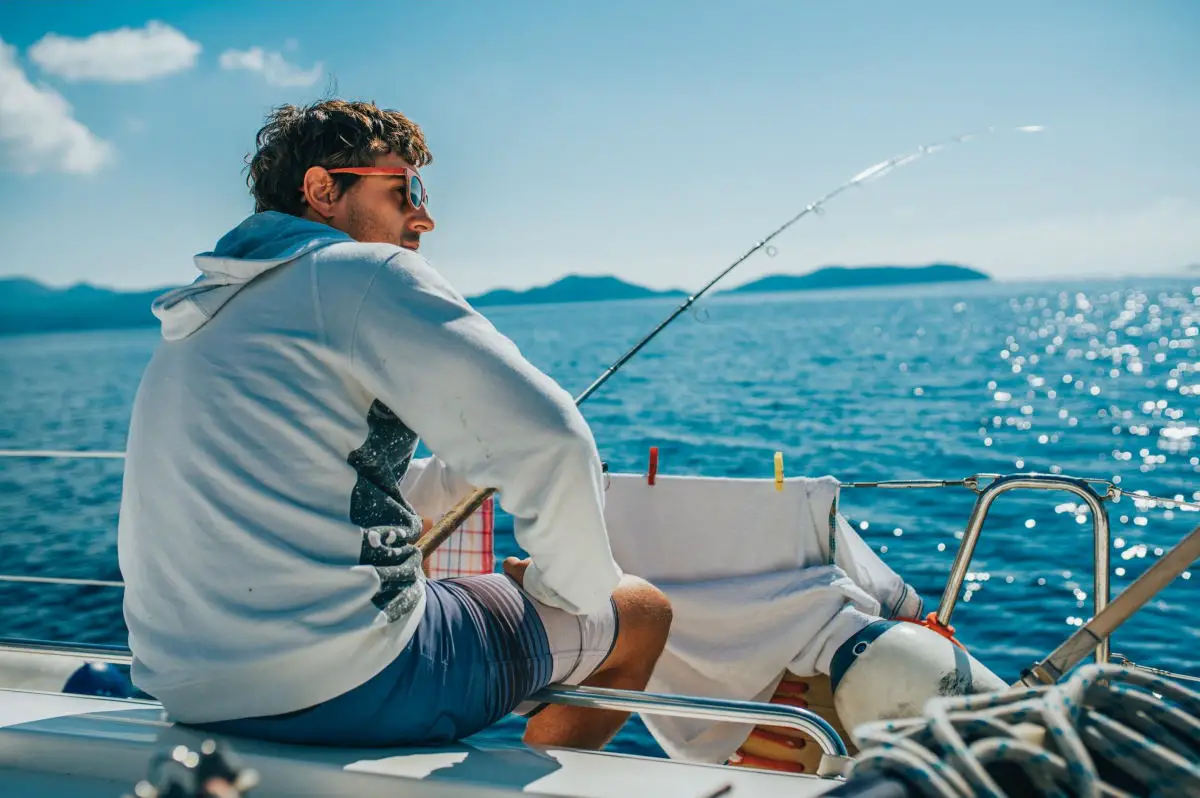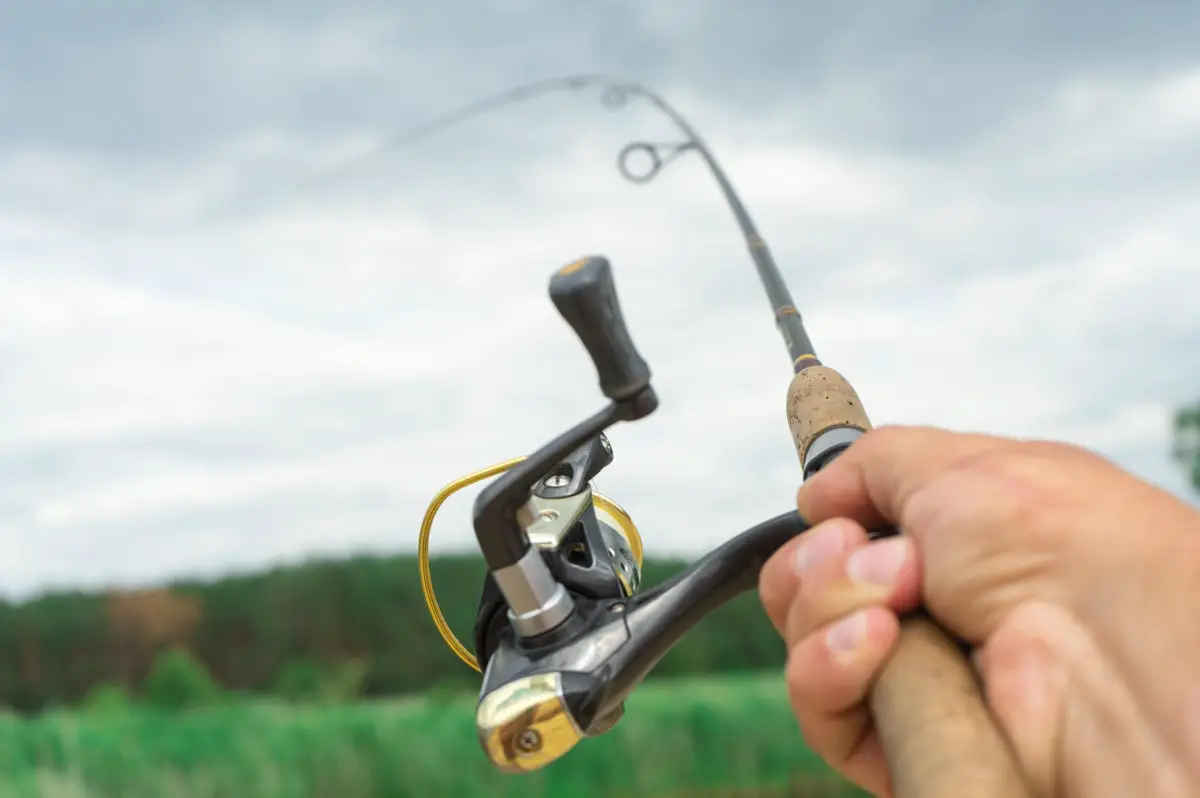Are you looking for a fun day to fish on a peaceful lake? Clear Lake in the Mount Hood area could be a great place for you. However, when you go to a new lake, it helps to have directions giving you the best chance of success.
For the best fishing at Clear Lake, troll along the shorelines just past where the bank slope meets the lake bed. Also, try to fish the most shaded areas depending on the time of day, east bank in the morning.
In this article, we will break down the lake and our favorite tactics for putting a limit of fish in the boat.
Note: most links in this article are Amazon.com Affiliate links, see Affiliate Disclosure, thank you.
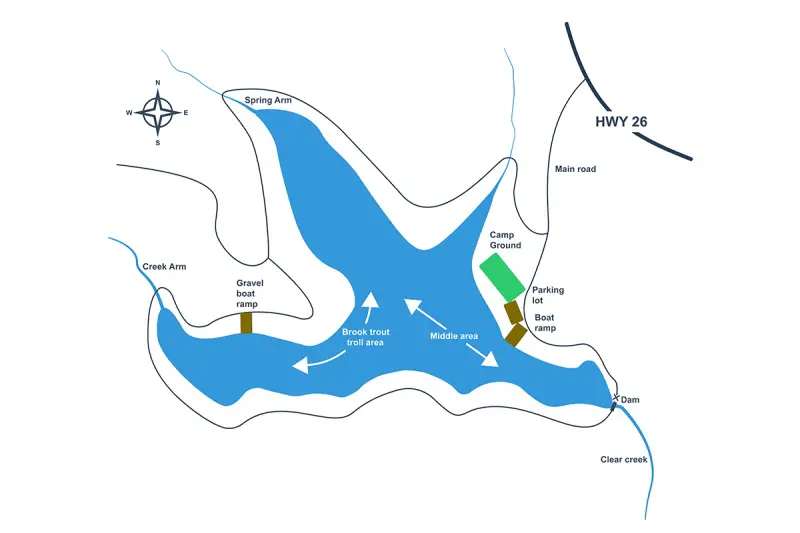
What are the details of Mount Hood’s Clear Lake?
Clear Lake is an irrigation reservoir located off HWY 26 just south of mount hood in the cascade mountain range. The reservoir is approximately 557 acres in size at full pool (or roughly 1 square mile), typically in mid-spring.
The dot gov website says the lake is 26 feet in average depth, but that is not the case. The average depth of Clear Lake is 14 feet, with a maximum depth of 20 feet directly in front of the dam intake. You will find some spots that run deeper than 14 feet, like the brook trout area on my map.
Technically, Clear Lake is in the Central Oregon Zone, while Most of the other lakes in the area are in the Willamette Zone. Because the cascade mountain range is where Clear Lake is located, a slight slope changes everything. Clear Creek exits the reservoir and then turns east, heading directly into the Central Zone and the Warm Springs Indian Reservation.
Because Clear Lake is used for irrigation, it is typical for the lake to run dry at the end of July, so it is a spring and early summer fishery. Also, summer fishing can be slow mid-day when the sun is high and bright.
Recreation is a top draw for Clear Lake because of available facilities and proximity to the Portland, Oregon Metro area. There is a full campground with 32 spaces(reservable) and a large number of unimproved campsites. Always keep an eye on the fire restrictions, as it is common to limit or forbid campfires entirely during the summer months.
Additionally, there is a lot of parking for day use like picnics or riding your mountain bike. The Clear Lake recreation area is a day-fee area, so bring some cash. When writing this article, the day-use fee was $5.00 per vehicle.
What Kind of Fish are in Clear Lake?
Clear Lake contains rainbow trout and brook trout. Oregon Fish and Wildlife stock the rainbow trout. Eastern brook trout are a char species that tastes similar to salmon. Brook trout are not native but live in the lake and surrounding streams.
Fish stocking for Clear Lake starts as soon as the roads are clear of snow a can run through June, depending on lake water levels. As of writing this article, 18,000 hatchery rainbow trout of all sizes have been reported as delivered during May.
The stocked fish are categorized into three groups: Legals, Trophy, and Brood. Most of the fish stocked are in the legals category, 95%, roughly 8 to 10 inches in length.
Fishing runs in cycles at Clear Lake unless the lake runs dry. The best rainbow trout fishing is in spring or early summer. The next best time of the year to fish is in fall after the first full week of rain. At the end of the season, the fish seem to feed more to prepare for winter.
How many Rainbow Trout can I Catch at Clear Lake?
At the time of writing, the limit for Clear Lake is five fish per day per person over 8 inches, of which only one may be over 20 inches. This limit is the general limit for all lakes in the Oregon Central Zone but can change on a location-by-location basis throughout the season.
I always recommend you check your regulations the morning you go fishing in case of any last-minute rule changes. However, the only change I have seen for Clear Lake in the past is the removal of limits because of low water levels.
Since we are talking about regulations, this is a great time to discuss Two-Rod Validation. In Oregon, you can purchase a Two-Rod Validation for use on all standing bodies of water, such as lakes, ponds, and reservoirs. There are some exemptions and one notable special allowance, the Willamette River. Keep up to date on this opportunity; start by seeing page 7 in the 2022 Oregon fishing regulations.
What is the best method to fish Clear Lake?
In my experience Trolling is the best method for targeting fish in Clear Lake. You can track the fish down and entice them to bite.
Trolling is slowly moving around the lake with a flasher and a bait, like worms. My preferred flasher to troll is a Ford Fender Lake Trolls.
Behind the lake troll, 18 to 36 inches of leader with a worm hook and half a night crawler makes a great bait.
Everyone has their favorite method for targeting fish, and mine is trolling. My most productive method for catching fish from the shore or on anchor is Powerbait. Another method is a bobber and worm, but don’t forget fireball eggs.
From time to time, you will see people fly fishing, but typically the best areas for that are small coves or incoming water sources.
What are the Main Fishing Areas at Clear Lake?
Most lakes can be broken down into areas, and a smaller lake like Clear Lake is no exception. I have divided the lake into four areas, the spring arm, the creek arm, the middle, and the dam area. Viewing the area in smaller sections makes it easier to fish each area correctly.
If you want to get your lake troll setup check out my article Best Lake Troll for Rainbow Trout

Spring arm
In the morning, I launch the boat at the main boat ramp and point the trolling motor north by north-west. I run my speed just a touch fast until I get all my poles in the water and working.
When I am sure everything is deployed without snagging, I slow the boat speed down to 1mph or slightly slower. I aim to follow the east shoreline where the lake bed levels out for my first morning pass.
I like to troll up to the end of the spring arm until I start losing depth, then slightly increase speed and make a big looping turn. If you don’t increase your speed here, your gear can get tangled up on the many stumps that are hidden across the lake bottom.
Something else you will notice in this area is a drop in water temperature. Cooler water from the spring can help fishing midday in early summer.
Next, I follow the west shore of the spring arm toward the point in the center of the lake. If catching has been good, I will reel up the poles for a sharp turn and repeat the pass where I got the most bites.
This area can be great any time of day, but especially if you use the topographical features to your advantage. Often the wind blows from the north at Clear Lake, making it unfishable some days. The wind can be cut in half if you fish close to the east shore. Also, the hills can give you shade on sunny mornings or sunny afternoons.
Don’t forget to adjust your boat speed to account for headwind slowing you down or tailwind giving you a push. If your flashers are not working correctly, you will not catch many fish.
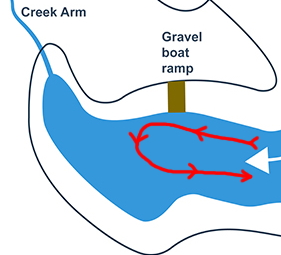
Creek arm
On slow days or as a second location, I like to head for a loop on the creek arm. This arm is the shallowest area of the lake, so you need to watch your depth carefully, or you could lose a lot of gear.
If I start in the brook trout area, it is a natural path to continue along the shore to the gravel boat ramp. Once I get to the gravel boat ramp, I start my slow left turn but don’t go completely to the other side of the arm because there are many snags on the lake bed.
This is an area where I catch a lot of fish on the turn, so don’t skip the high-speed turn. Typically, I reel the inside turn fishing pole(left side) halfway in to prevent snagging, which will still catch fish.
If you are fishing from a float tube, kayak, or raft, the shallow area is a great place to fly fish because big fish that are holdovers will be waiting in ambush.
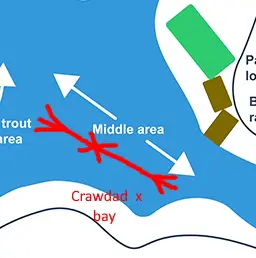
The middle
Never skip the middle area. Technically, it is more the opposite side of the lake from the boat ramp than the middle. Once you are across from the boat ramp, the lake has a nice average depth. However, the boat ramp area is shallow, making it difficult to fish.
When they stock the fish, the truck backs down the boat ramp and dumps in one to two feet of water. The fish slowly dispersed there, but it takes a few days for them to completely acclimate and swim freely.
Many of those new hatchery fish migrate across from the ramp. Then they head to the bottom until they have adjusted. This area is also my favorite area to use lures with a worm slug, like triple teasers, rooster tails, dick nites, and wedding rings.
This area was my grandma’s favorite spot to fish. She always said, “if I can’t see mt. Hood, I can’t catch fish.” It worked for her.
If you want to set crawdad traps, there is a small bay full of crawdads out of the trolling lanes, and it is a great spot to clean your fish.
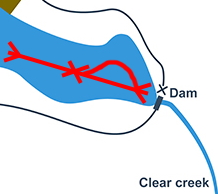
The dam area
The most challenging area to fish in is the dam area. Because of how narrow the lake is, it can be hard to make a turn while fishing. I like to fish down the center and point directly at the dam control in this section.
Once I reach the dam, I reel in the poles and turn the boat around to restart in the other direction. This area is the deepest of the lake, and I like to add a bit of weight and shorten my line count. I prefer to put ½ oz or more weight on the line and only deploy forty feet of line.
In most windy conditions, the dam area will be challenging to fish. Also, there are a lot of bank anglers in this area because of overflow camping and the day-use area.
Finally, this area is a favorite for people to swim in the lake, and I have even seen people diving off the bank by the dam; that’s not good for fishing.
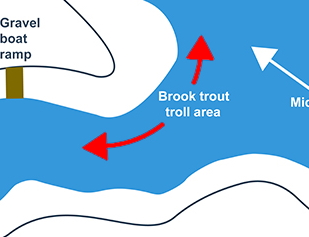
Bonus Brook Trout Area
My father’s favorite area is the brook trout area, by far. If there is no wind, this can be a great place to start your day.
Head straight from the boat ramp to the point in the lake’s center, turn left and start fishing. The bank is very steep in this area, so you can get in tight if no one is fishing from shore. On a day when the wind is coming out of the west, this area can be very productive even though it is a short run.
Also, the brook trout area has consistent depth and very few snags, which will allow you to use a little weight. Adding just a bit of weight helps deploy faster and keeps your gear from surfacing in wind gusts.
Remember that while we call this the brook trout area, it is just as good for rainbow trout. When you target brook trout, use a large piece of worm and slide it completely up the hook.
Tips and Tricks for Clear Lake
While there are many options for gear when I fish rainbow trout, I stick with Ford Fenders Lake Trolls or generic knock-offs. I vary the color depending on the weather. When it is cloudy out, I start with silver (aka nickel); when it is sunny out, I start with gold (aka brass); when I am not sure, I put out a 50/50.
My preferred hook is an eagle claw #6 worm hook on 18 to 36 inches of six-pound leader. When I put a worm on a hook, I start with half a nightcrawler and slide it up, making a point to cover the hook completely and not leave the worm dangling behind. If the fish are nibbling and not getting hooked, I will use the fishing plyers to open the gap slightly.
I try to avoid using weight on my rigs unless it is necessary. When the lake is low in the middle of July, I will attach a boober about 10 feet up the line from my lake troll. Consider keeping some clear boobers in your tackle box, but a regular red and white will work fine.
No wind sounds great, but it is not. The best wind is a light wind that creates a ripple on the surface, preventing fish from seeing you. I have taken extra long poles without hooks and dragged them in the front pole holders to put ripples in the water, which works.
Wrapping up Clear Lake
When you want a great day of fishing or a few fish and a great place to have lunch Clear Lake will not disappoint. This lake is an excellent location to camp and fish all in one trip.
With the breakdown of the lake and the tips I have provided, you will catch more fish. This information will give you, your friends, and your family a great experience.
